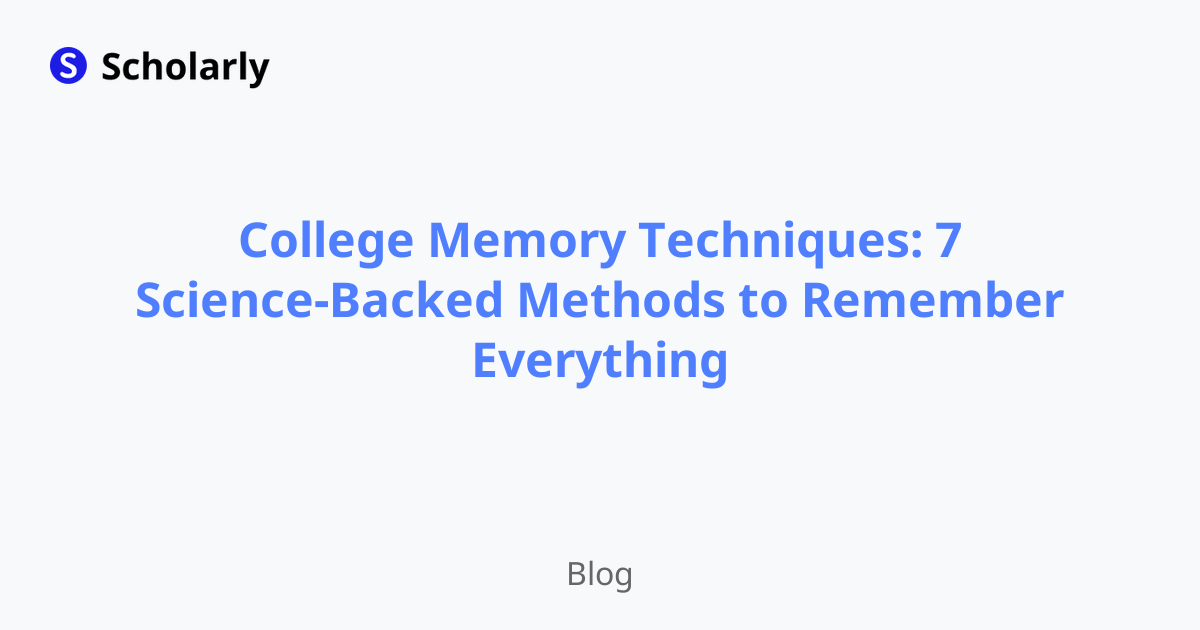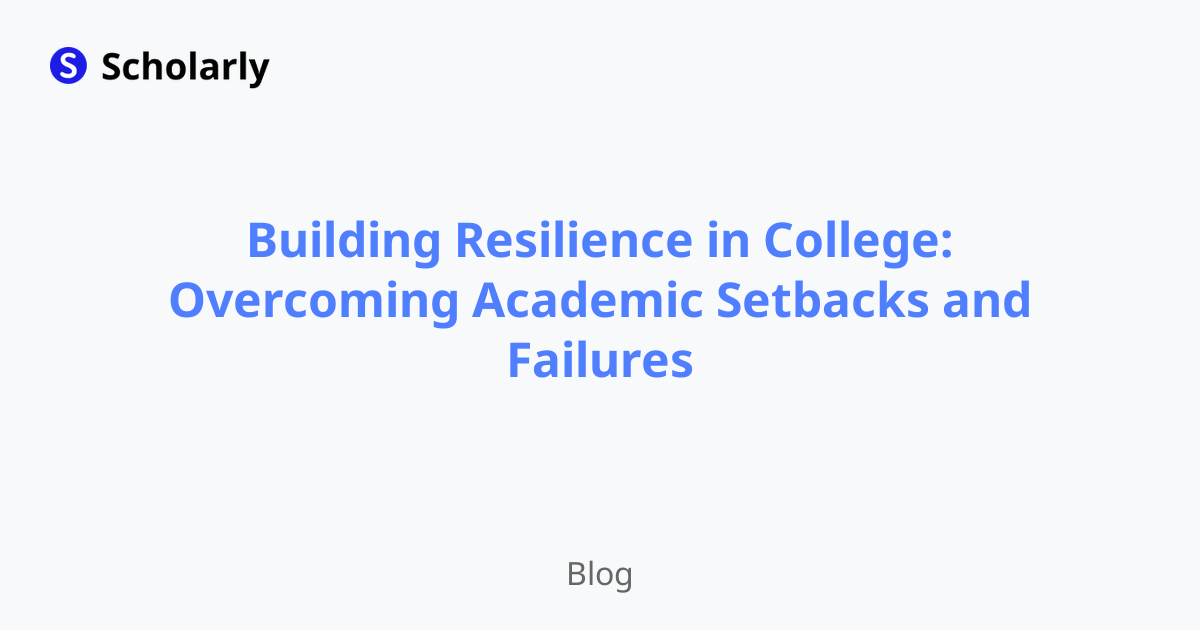College Memory Techniques: 7 Science-Backed Methods to Remember Everything
Master proven memory techniques that can triple your retention rate. Learn how memory champions and top students use science-based methods to remember vast amounts of information.

Introduction
Struggling to remember what you studied last week? You're not alone. The average college student forgets 50% of new information within an hour and 90% within a week without proper memory techniques. But here's the game-changer: memory isn't fixed. It's a skill that can be dramatically improved using scientifically proven methods. Memory champions can memorize thousands of random numbers or entire decks of cards using techniques that anyone can learn. This guide reveals seven powerful, research-backed memory methods that will transform how you absorb, retain, and recall information throughout your college career and beyond.
History
Memory techniques, or mnemonics, have ancient origins dating back to Greek and Roman orators who memorized hours-long speeches without notes. The "Method of Loci" was developed in ancient Greece, while medieval scholars used elaborate memory palaces to store vast amounts of knowledge before books became widely available. The scientific study of memory began in the 1880s with Hermann Ebbinghaus's groundbreaking research on forgetting curves and spaced repetition. The 20th century brought cognitive psychology advances, with researchers like Alan Baddeley developing working memory models that explain why certain techniques are so effective.
Current State
Modern neuroscience has validated many ancient memory techniques while revealing the brain mechanisms that make them work. fMRI studies show that memory techniques activate multiple brain regions simultaneously, creating stronger neural networks than passive repetition. Today's memory athletes regularly demonstrate extraordinary feats—memorizing 2,000+ random digits or 40+ decks of cards—using techniques available to any college student. However, surveys show that less than 15% of students actively use advanced memory techniques, despite their proven effectiveness for academic performance.
Future State
The future of memory enhancement will likely integrate brain stimulation technologies, virtual reality training environments, and AI-powered personalized memory protocols. Researchers are exploring how transcranial stimulation can enhance memory consolidation during sleep. Virtual reality may soon provide immersive memory palace environments for spatial memory techniques. AI systems will analyze individual forgetting patterns to optimize spaced repetition schedules. Despite technological advances, the fundamental principles of memory—association, visualization, and repetition—will remain central to effective learning.
Benefits
- Massive Retention Improvement: Proper techniques can increase retention from 20% to 80%+ after one week
- Faster Information Absorption: Memory techniques can speed up initial learning by 200-400%
- Reduced Study Time: Better retention means less time spent re-learning forgotten material
- Enhanced Creativity and Problem-Solving: Memory techniques strengthen associative thinking abilities
- Improved Confidence: Reliable memory creates confidence in academic and professional settings
- Lifelong Learning Skills: Memory techniques remain valuable throughout career and personal development
Significance
Memory techniques represent fundamental cognitive tools that transform not just academic performance but overall intellectual capacity. Students who master these methods often report feeling more confident, capable, and in control of their learning. Beyond college, strong memory skills are crucial for professional success—from remembering client names and details to mastering complex procedures and information. The ability to rapidly acquire and retain new information becomes increasingly valuable in our fast-changing economy.
Best Practices
- Start with Simple Techniques: Master basic methods before progressing to advanced systems
- Practice Regularly: Like physical exercise, memory skills require consistent training
- Use Multiple Techniques: Combine different methods for maximum effectiveness
- Create Vivid, Personal Associations: The more unusual and personal, the more memorable
- Test Your Memory Actively: Regular recall practice strengthens memory traces
- Be Patient with Initial Effort: Memory techniques require upfront investment but pay massive dividends
Pros and Cons
Pros:
- Dramatic improvement in retention and recall capabilities for all subjects
- Significant reduction in time spent re-learning previously studied material
- Enhanced creativity and associative thinking abilities
- Improved confidence and reduced anxiety about forgetting important information
- Lifelong skills that continue providing value beyond college
- Can make studying more engaging and enjoyable through creative techniques
Cons:
- Initial learning curve requires time and effort investment before seeing benefits
- Some techniques may feel unnatural or silly at first, requiring mental adjustment
- Not all information types are equally suited to memory technique application
- Can be time-intensive to create elaborate memory systems for complex subjects
- Risk of over-relying on techniques without understanding underlying concepts
- May require regular maintenance and practice to keep memory systems sharp
Comparison
Different memory techniques excel in different contexts:
Method of Loci (Memory Palace): Best for sequential information like speeches, procedures, or lists. Extremely powerful but requires initial setup time.
Acronyms and Acrostics: Quick and easy for short lists or sequences. Limited to specific types of information but very accessible.
Visual Association: Excellent for vocabulary, names, and abstract concepts. Works well for most people but requires creativity.
Chunking and Patterns: Perfect for numbers, formulas, and structured information. Most useful for quantitative subjects.
Story Method: Great for unrelated items and creative subjects. Fun and engaging but can become unwieldy for large amounts of information.
Methods
1. The Memory Palace (Method of Loci)
Choose a familiar location like your home and assign information to specific locations along a consistent route. To remember a biology process, walk mentally through your house, placing each step at different rooms. When recalling, simply retrace your mental path. This technique leverages spatial memory, one of the brain's strongest memory systems.
2. Visual Association and Imagery
Transform abstract information into vivid, unusual mental images. To remember that mitochondria produce ATP, visualize a tiny factory (mitochondria) manufacturing glowing energy balls (ATP). The more bizarre and detailed the image, the more memorable it becomes. This works because the brain processes visual information more effectively than abstract concepts.
3. The Story Method
Connect unrelated items by creating a narrative that links them together. To remember a list of historical events, create a story where each event leads logically to the next. The narrative structure provides retrieval cues and makes information more meaningful and memorable.
4. Chunking and Pattern Recognition
Break large amounts of information into smaller, meaningful chunks. Phone numbers are easier as 555-123-4567 than 5551234567. For formulas, identify patterns and recurring elements. This technique works with the brain's limited working memory capacity by organizing information more efficiently.
5. Acronyms and Acrostics
Create memorable phrases where each first letter represents information you need to remember. "Roy G. Biv" for rainbow colors or "Please Excuse My Dear Aunt Sally" for mathematical order of operations. This technique provides strong retrieval cues and works especially well for sequential information.
6. The Peg System
Memorize a set of "pegs" (rhymes with numbers: one-sun, two-shoe, three-tree) then hang new information on these pegs through visualization. To remember your third point in a presentation, visualize it happening in a tree. This creates an organized mental filing system for ordered information.
7. Spaced Repetition with Elaboration
Review information at increasing intervals (1 day, 3 days, 1 week, 2 weeks) while adding personal connections and explanations each time. Don't just repeat facts—elaborate on why they're important, how they connect to other knowledge, and what implications they have. This strengthens memory through both spacing and meaningful processing.
AI Impact
Artificial intelligence is revolutionizing memory training through personalized spaced repetition algorithms that adapt to individual forgetting patterns. AI can analyze which types of information you forget most quickly and suggest optimal memory techniques for different content types. Virtual reality environments powered by AI create immersive memory palaces that respond to your preferences and learning style.
Machine learning algorithms can generate optimal visual associations and stories based on your interests and existing knowledge. Natural language processing helps AI tutors explain memory techniques in ways that resonate with individual learning styles. Future AI systems may provide real-time memory coaching, suggesting when to use specific techniques based on the type of information you're studying.
Common Techniques
- Rhymes and Rhythms: Using musical or poetic patterns to aid recall
- Color Coding: Associating different colors with different types of information
- Mind Mapping: Visual organization that leverages spatial and associative memory
- Keyword Method: Creating memorable keywords for foreign language vocabulary
- Number-Shape System: Associating numbers with similar-looking objects for easier recall
- First Letter Mnemonics: Creating words or phrases from first letters of lists
Challenges
- Initial Time Investment: Learning and implementing memory techniques requires upfront effort before benefits appear
- Technique Selection: Choosing the right method for different types of information can be confusing
- Maintenance Requirements: Memory systems need regular practice to remain effective
- Skepticism and Resistance: Some students dismiss techniques as "gimmicky" without trying them properly
- Creative Demands: Some techniques require imagination and creativity that may feel challenging initially
- Integration with Understanding: Risk of memorizing without truly comprehending underlying concepts
Potential Online Apps that Relate to the Topic
Anki: Sophisticated spaced repetition flashcard system that optimizes review schedules based on your forgetting patterns and memory strength.
Lumosity: Brain training platform with memory-specific games and exercises designed to strengthen working memory and recall abilities.
Memory Palace: Dedicated app for building and practicing virtual memory palaces with customizable environments and guided training.
Quizlet: Popular study platform that incorporates multiple memory techniques including spaced repetition, visual learning, and game-based practice.
Peak: Comprehensive brain training app with memory challenges, progress tracking, and personalized training programs.
Scholarly: AI-powered study platform that automatically applies memory techniques like spaced repetition to your course materials and creates optimized review schedules.
Conclusion
Memory techniques aren't just academic curiosities—they're practical tools that can transform your college experience and beyond. The methods outlined in this guide have been used by students, professionals, and memory champions for centuries because they work with, rather than against, how your brain naturally processes and stores information.
The key is starting simple and building gradually. Choose one technique that appeals to you and practice it consistently for two weeks. Once it becomes natural, add another method. Remember that the initial effort required to learn these techniques pays massive dividends in reduced study time and improved performance throughout your academic and professional career.
Most importantly, view memory not as a limitation but as a skill to be developed. Your brain has virtually unlimited capacity for storing information when you use the right techniques. The students who master these methods often find that learning becomes not just more effective but actually enjoyable as they discover their mind's incredible capabilities.
Try Our Popular AI Study Tools
Transform your study materials into interactive learning experiences with our most popular AI-powered tools:
PDF to Flashcards
Convert lecture notes and textbooks into study flashcards instantly
Text to Flashcards
Turn any text or notes into comprehensive flashcard sets
Image to Flashcards
Convert diagrams and handwritten notes into digital flashcards
YouTube to Flashcards
Generate flashcards from educational video content



